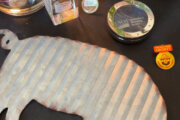From time to time, we all eat foods that may not agree with us. Whether it’s an actual food allergy or sensitivity, or just a food item that causes indigestion or bloating, there’s a wide range of ways that what we eat can negatively impact how we feel.
For some people with certain digestive conditions, these issues go beyond the mundane bit of heartburn and can cause more chronic problems. And foods that are high in FODMAPs may be to blame.
“FODMAPs are sugars, or carbohydrates, that are found in certain foods,” says Shelley Wood, a registered dietitian nutritionist with Santa Clara Valley Medical Center in San Jose, California. “FODMAP stands for Fermentable Oligo-Di-Monosaccharides and Polyols.”
FODMAPs are “naturally found in many nutritious foods that we normally eat, but some people may be sensitive to them,” says Melissa Perry, a registered dietitian with Orlando Health in Orlando, Florida. “FODMAPs can draw extra water into your digestive tract and be fermented by the bacteria in your gut. Someone with low tolerance for these FODMAPs may feel bloated, gassy and have abdominal pain or diarrhea.”
Dr. Rajsree Nambudripad, integrative medicine specialist with St. Jude Medical Center in Fullerton, California, explains that FODMAPs are “short-chain carbohydrates that are a bit more complex to digest, so they sometimes create gas and bloating in certain patients, especially those suffering from a condition called small intestine bacterial overgrowth, or SIBO.”
When eaten in excess, FODMAPs can cause some unpleasant symptoms including:
— Bloating.
— Stomach pain or cramping.
— Diarrhea.
People with certain bowel diseases and conditions may be particularly sensitive to foods that are high in FODMAPs. If you have any of the following conditions, you might want to investigate following a low-FODMAP diet:
— Non-celiac gluten sensitivity.
[READ: The Benefits of Elimination Diets.]
The FODMAP Diet
Wood explains that the FODMAP diet “is an elimination diet that consists of three phases” to help you determine what foods will work with you and which ones cause gastric distress.
Phase 1: Elimination
In the elimination phase, all high-FODMAP foods are eliminated, which should help show you whether you’re sensitive to FODMAPs.
“The elimination diet aspect of the diet is very restrictive and does take a lot of planning prior to starting it, but is only followed for two to six weeks.
Phase 2: Reintroduction
“In this second phase, there’s a reintroduction of one of the groups in a step-wise manner,” Wood explains. By reintroducing foods one at a time, you can find out which are problematic and which are OK to include in your diet going forward.
“You can introduce one new food each day or it may be helpful to introduce high-FODMAP foods slowly by adding one food back into your diet at a time,” Perry says. “You can try adding one food and then wait a couple of days before reintroducing another food. It’s important to keep a detailed food symptom diary or record of triggering foods that cause symptoms and the severity and onset of those symptoms,” during this phase, so you can determine which foods cause the most problems.
Phase 3: Maintenance
The final, maintenance phase consists of “all foods, excluding those that exhibited symptoms, and is continued from then on as the individual’s every-day eating pattern,” Wood says.
[READ: Paleo vs. Whole30: Which Is Better?]
Foods to Avoid When Starting a Low FODMAP Diet
These lists are not exhaustive, but should give you a starting point when trying to build a diet that eliminates FODMAPs. You can check the FODMAP rating for foods using one of several smartphone apps or websites that track these values.
Foods that contain FODMAPs include:
— Grains: Not all whole grains are problematic, but wheat, rye, barley and amaranth contain high levels of FODMAPs. Therefore, bread, crackers, cookies, couscous, pasta and pastries made from these grains are restricted.
— Protein: Fatty or fried meats and processed meat products that contain marinades with garlic or onion may be high in FODMAPS. Chickpeas, lentils, soybeans, pistachios and cashews are other high-protein foods that contain FODMAPs.
— Dairy: Cow, goat or sheep milk products, including custard, ice cream, yogurt and soft cheeses such as cottage cheese, cream cheese and ricotta.
— Vegetables: Artichoke, asparagus, cauliflower, garlic, leek, mushrooms, onion and shallots.
— Fruit: Apple, apricot, avocado, blackberry, cherry, mango, nectarines, peach, pear, persimmon, plum, prune and watermelon.
— Sweeteners: Fructose, which is found in fruits, honey, high fructose corn syrup and agave syrup, and artificial sweeteners such as sorbitol, mannitol, xylitol, isomalt and maltitol.
— Beverages: Chamomile tea, fruit juices, coconut water, wine, beer and rum.
[READ: ADHD Diet for Kids: What All Parents and Health Providers Should Know.]
Foods to Eat on a Low- FODMAP Diet
“An easy way to think of the low-FODMAP diet is that it’s similar to a paleo diet but excludes fruits, garlic and onion,” Wood says.
— Grains: Gluten-free bread or cereal products, 100% spelt bread, rice, oats, polenta, cornmeal, arrowroot, millet, quinoa, tapioca and sorghum.
— Protein: Lean meat, poultry, fish, eggs, tempeh, tofu and seeds.
— Lactose-free dairy and non-dairy alternatives: These include lactose-free milk, almond milk, rice milk, soy milk made from soybean extract (not whole soybeans), lactose-free yogurt, lactose-free ice cream and sorbets made from suitable fruits and sweeteners. Dairy products that are lower in FODMAPs include hard cheeses, brie, Camembert and cheddar.
— Most nuts and seeds: And the butters of most nuts and seeds. (Cashews and pistachios contain higher levels of FODMAPs.)
— Certain fruits: Bananas, berries, cantaloupes, honeydew melon, kiwi, grapes, passion fruit, citrus fruits and pineapple.
— Many vegetables: Alfalfa sprouts, bamboo shoots, bean shoots, bell peppers, bok choy, cucumbers, carrots, celery, corn, eggplant, green beans, lettuce, olives, parsnip, potato, pumpkin, spinach, squash, sweet potato, tomato, turnip yam and zucchini.
— Most spices and herbs: Basil, coriander, mint, oregano, parsley, rosemary and thyme.
— Oils: Vegetable oils, such as corn and olive oils.
— Sweeteners: Maple syrup, molasses, sucrose (table sugar, cane sugar), artificial sweeteners not ending in ‘-ol’ such as aspartame, stevia and saccharine.
— Drinks: Low-FODMAP fruit and vegetable juices, coffee and tea.
Be careful to read the label on any prepared or processed foods. Chicory root, which is a big source of inulin, a type of fiber in plant foods that contains FODMAPs “is often a hidden ingredient in health bars,” Nambudripad says. It “can be a culprit for gas and bloating in certain patients sensitive to FODMAPs due to possible SIBO.”
Is the FODMAP Diet Right for Me?
If you’re having gastrointestinal issues and looking for relief, Tracy says you may want to consider the FODMAP diet. But, “it’s important to speak with your primary care doctor or your GI doctor if you plan to follow this diet.”
You need to first “rule out allergies or disease,” Perry adds.
You should also discuss this diet with a registered dietitian who’s familiar the diet because “the FODMAP diet is restrictive and confusing without guidance,” Wood says. Without the assistance of a dietitian counseling and monitoring your intake, you could end up with nutritional deficiencies or malnourishment. “The FODMAP diet should never be attempted without consulting with a registered dietitian trained in gastrointestinal conditions,” she adds.
“If you’re experiencing unexplained symptoms such as bloating and distention, abdominal pain and diarrhea, please get a referral to see a physician who specializes in gastrointestinal issues and work with a registered dietitian to develop a personalized diet,” Wood says.
Tracy agrees that you need to get the right diagnosis before embarking on a FODMAP diet. “Avoid self-diagnosing yourself if you are having GI discomfort. Remember to speak with a health professional who can rule out more serious GI issues.”
Nambudripad adds that “if your gut is healthy, you should have no problems digesting and breaking down FODMAPs. But if you have a condition such as SIBO, a low-FODMAP diet may help, along with an antibiotic or herbal antimicrobial to kill the offending bacteria.” You’ll need to work with a health care provider to get that diagnosis and proper treatment. And, she doesn’t recommend staying on a low-FODMAP diet long term, since it can affect your gut’s ability to digest these types of carbohydrates and also affect your gut microbiome — the bacterial ecosystem of your gut.
Perry adds that “FODMAPs aren’t bad, and avoiding them doesn’t help everyone.” They’re just a component of certain foods that some people have difficulty digesting. “Many nutritious foods are rich in FODMAPs and can also promote good bacteria growth in the gut, so be sure to consult your medical professional or RDN prior to starting a low-FODMAP diet.”
More from U.S. News
Foods to Avoid During an Ulcerative Colitis Flare-Up
Specific Carbohydrate Diet Food List
7 Traditional Chinese and Indian Eating Principles That Can Help You Lose Weight
What Is FODMAP Diet? Does It Work? originally appeared on usnews.com







